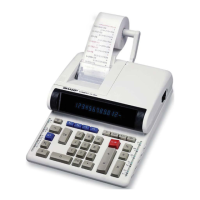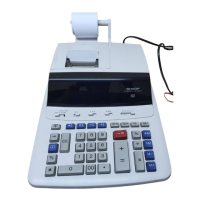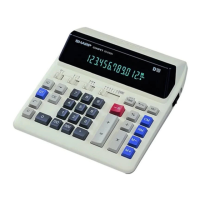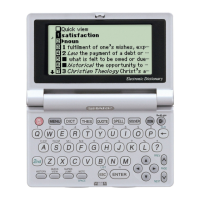8
•
Input buffer
Remaining 80 bytes (10 memories equivalent) of the display chip
1
is
used for the input
buffer
,
whi
c
h
is
used in the following
fun
c
tions:
1.
Any information entered through the keyboard
is
stored once in this
buffer
,
thus allowing up
to 80 steps.
2. The display contents
is
stored by the CPU
I
and the CPU II makes selection out of this
da
t
a.
3
.
When an
arithmet
i
cal instruction
i
s
entered
,
its
p
rocedure
is
stored in this buffer by the CPU
I
and the CPU
II
performs operation accord
i
ng to this procedure.
4
.
When program or reserve program
is
t
o
be recorded or read out during the execution of the
cassette control
instruction
,
action takes place through this input buffer.
•
Transfer buffer
8
bytes
(1
memory
equi
v
alent) of the
displa
y
c
hi
p
1
i
s
used
as
a
transfer buffer
w
h
ic
h
is
used in
the
transa
c
t
i
on of instruction between the
C
PU
I
and the CPU II.
16
b
i
ts
----1}4bit
1
memory
•
Fixed memory
The total memory of 176 bytes from the display chip
2
and
3
is
used
as a
fixed
memories
,
A
-
V
(22 memories).
•
8-digit display buffer
40 bytes of 8-digit display buffer
is
used
as a
display data buffer during displaying and also used
as
a
buffer memory for arithmetical result during the arithmetical operation.
128
80 step input buffer
Fixed memories
(L-V
,
11
memories)
Fixed memories
(A-K
,
11
memories)
Transfer buffer
040
04
8
8-digit display buffer
8-digit display buffer
8-digit display buffer
000
DISPLAY CHIP
3
DISPLAY CHIP
2
DISPLAY CHIP
1
•
Map of the RAM incorporated in the display chip
There are three lK-bit RAMs (128 bytes each) incorporated in each of display chips (SC43125),
having the following
configurations
:

